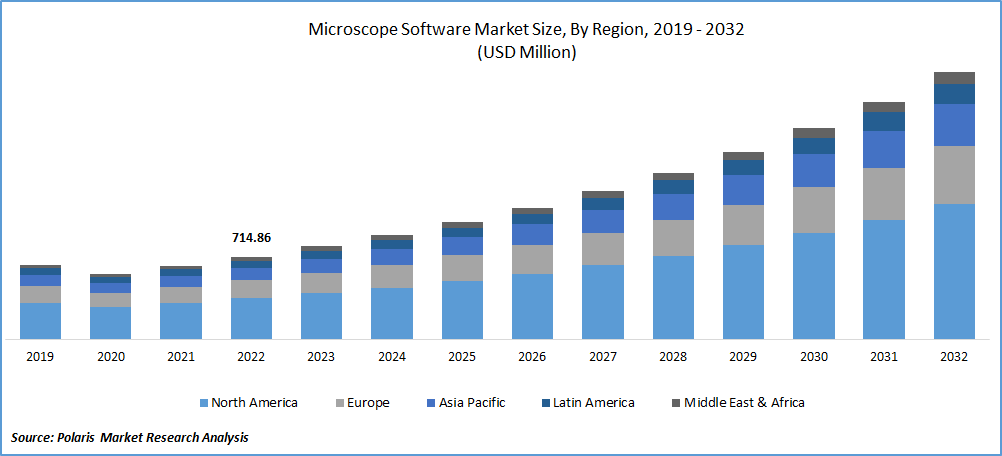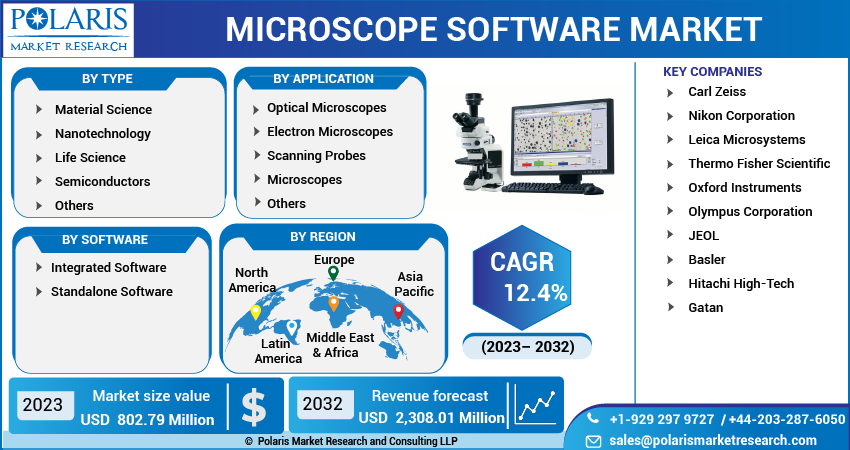
Microscope Software Market Share, Size, Trends, Industry Analysis Report, By Software (Integrated Software, Standalone Software), By Microscope Type (Optical, Electron, Scanning Probes), By Application, By Region, And Segment Forecast, 2023 - 2032
- Published Date:Jul-2023
- Pages: 112
- Format: PDF
- Report ID: PM3575
- Base Year: 2022
- Historical Data: 2019-2021
Report Outlook
The global microscope software market was valued at USD 714.86 million in 2022 and is expected to grow at a CAGR of 12.4% during the forecast period. The rising availability of funding and support for research and development in microscopy, along with notable advancements in microscope technology and software. Additionally, increased government funding to enhance microscope software's utilization in precision modeling and virus imaging has significantly driven market growth.

To Understand More About this Research: Request a Free Sample Report
The utilization of microscope software facilitates the seamless sharing and collaboration of research data. Through cloud-based storage and sharing platforms, researchers can conveniently and securely exchange their images and data with colleagues and collaborators worldwide, enabling enhanced efficiency and effectiveness in collaboration. A research article published in Wiley Analytical Science in May 2022 highlighted the potential of OMERO, a microscopy image database, as a valuable tool for research data management. Integrating OMERO into an organization's IT infrastructure would assist scientists in effectively managing microscopy data.
The microscope software market has experienced a positive impact due to the COVID-19 pandemic, as there has been a rise in demand for medical research and diagnostic tools. This increased demand has also created a higher need for software solutions for microscopes. Moreover, companies are allocating financial resources to conduct research, develop potential vaccines, supply or manufacture medical equipment, and produce test kits.

For Specific Research Requirements, Request for a Customized Report
Industry Dynamics
Growth Drivers
Enhancing analysis and research is crucial for various industries, and the demand for improved performance and reliability drives the adoption of digital microscopes with advanced software. These microscopes are vital in documentation, research, quality control, production, and failure analysis across multiple sectors. Industries such as natural science, pharmaceuticals, medical, aerospace, machining, and microelectronics can benefit from integrating digital microscopes with software.
A notable example is the VHX-7000 series digital microscope developed by Keyence Corporation. This innovative microscope combines analysis software with high-resolution 4K imaging, increasing efficiency in various work processes. Researchers using this device can capture high-resolution 4K images and perform 3D or 2D measurements, all within a single platform. This integrated system can overcome many challenges associated with traditional microscopes and scanning electron microscopes (SEMs).
Report Segmentation
The market is primarily segmented based on type, software, application, and region.
|
By Type |
By Software |
By Application |
By Region |
|
|
|
|
To Understand the Scope of this Report: Speak to Analyst
Electron microscope segment accounted for the largest market share in 2022
The electron microscope segment accounted for the largest market share. Well-funded research laboratories and industries primarily use these microscopes, which are more expensive than optical microscopes. However, the market penetration of electron microscopes is expected to grow as the connections between academic and research institutions and manufacturers strengthen.
The scanning probe microscopes segment recorded a steady growth rate. These instruments are utilized for studying specimens at the nanoscale and manipulating atoms to achieve specific patterns. In December 2019, Marposs launched a software package compatible with its probes. This software calculates the optimal cycle time for machines by allowing users to input the desired repeatability range and workpiece positioning tolerance. According to the company, this package can reduce cycle time by up to 80%, ensuring rapid and precise probing. The introduction of industry-specific innovations is expected to increase the demand for microscopes.
Integrated microscope segment garnered largest share in 2022
The integrated microscope segment held the largest revenue share. This dominance can be attributed to the high adoption rate by researchers, as integrated microscopes can combine multiple imaging techniques, allowing for a comprehensive analysis of samples. Moreover, these integrated systems offer various functions, such as image processing, data analysis, and automation, all in one place. These software packages provide integrated features that enhance productivity, reduce costs, and streamline the time required to perform multiple medical, educational, and industrial tasks.
The standalone segment is expected to witness steady growth. This is primarily due to its extensive application in various fields, such as biology, materials science, and nanotechnology. As a result, there is an increased market demand for standalone microscope software solutions.
Life Sciences segment garnered largest share in 2022
The Life Sciences segment held the largest revenue share. This segment utilizes various types of compound microscopes, including inverted, upright, laser microdissection, fluorescence, and digital microscopes, for research purposes in life sciences. Additionally, the expanding application scope of these microscopes in disease diagnosis is a key driver for market growth. Moreover, there is an increasing focus on research and development in fields such as neuroscience, biological sciences, semiconductor, and nanotechnology, which is expected to boost the adoption of super-resolution microscopes. These advanced microscopes offer picture resolutions as high as 10 nm, crucial for studying cell signaling pathways and cancer cell proliferation.
The nanotechnology segment is expected to grow steadily over the study period. Significant investments are being made in research and development within the field of nanotechnology, leading to an expansion of product applications. The introduction of new software-driven microscopic devices for research purposes is anticipated to contribute positively to the growth of this segment. For example, in May 2018, JEOL collaborated with Digital Surf to release SMILE VIEW Map software, designed for use with their scanning electron microscope (SEM) systems. This software finds applications in various industries, such as biology, medicine, ceramics, semiconductors, metals, and nanotechnology.
North America dominated the global market in 2022
North America dominated the global market with a considerable market share. It is a well-established market with prominent players like Danaher Corporation, Carl Zeiss, & Thermo Fisher Scientific. These companies have a strong foothold in the region, supported by a wide customer base and well-established distribution networks. Adopting advanced microscopy systems and software, including digital microscopes, electron microscopes, and confocal microscopes, is notably high across various industries. Furthermore, these companies are actively involved in research and development activities to expand correlative microscopy applications in fields such as geology and materials science. This commitment to innovation contributes to the region's market growth.
APAC registered a robust growth rate. Increasing demand for diagnostic centers and the rising number of regional healthcare facilities contribute to the market's growth. Moreover, expanding research and development projects further augments the market's potential in the region.
The pharmaceutical and biotech companies are increasingly focusing on Latin America due to several factors, such as a lenient regulatory framework, a large pool of potential test subjects, and advanced research infrastructure. Governments in the region have also taken steps to streamline the approval process for clinical trials, acknowledging the competitive advantage it offers. As a result, there has been a significant surge in the demand for microscopes in the region.
Competitive Insight
Some of the major players operating in the global market include Carl Zeiss, Nikon Corporation, Leica Microsystems, Thermo Fisher Scientific, Oxford Instruments, Olympus Corporation, JEOL, Basler, Hitachi High-Tech, and Gatan.
Recent Developments
- In January 2023, Oxford Instruments recently introduced Imaris 10.0, the latest microscopic image analysis software iteration. This updated version brings significant advancements to the neuroscience community, allowing for enhanced resolution of neuron structures and improved speed in visualizing and calculating detected models. The launch of Imaris 10.0 provides researchers with a powerful tool for analyzing microscopic images in neuroscience and enables them to achieve more accurate and efficient analysis of neuronal structures.
Microscope Software Market Report Scope
|
Report Attributes |
Details |
|
Market size value in 2023 |
USD 802.79 million |
|
Revenue forecast in 2032 |
USD 2,308.01 million |
|
CAGR |
12.4% from 2023 – 2032 |
|
Base year |
2022 |
|
Historical data |
2019 – 2021 |
|
Forecast period |
2023 – 2032 |
|
Quantitative units |
Revenue in USD million/billion and CAGR from 2023 to 2032 |
|
Segments covered |
By Application, By Type, By Region |
|
Regional scope |
North America, Europe, Asia Pacific, Latin America; Middle East & Africa |
|
Key companies |
Carl Zeiss, Nikon Corporation, Leica Microsystems, Thermo Fisher Scientific, Oxford Instruments, Olympus Corporation, JEOL, Basler, Hitachi High-Tech, and Gatan |
FAQ's
The global microscope software market size is expected to reach USD 2,308.01 million by 2032.
